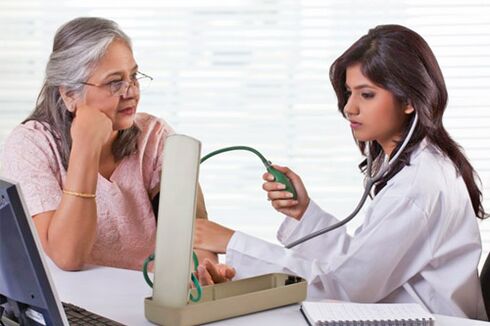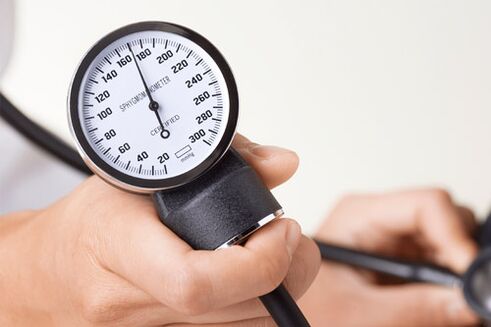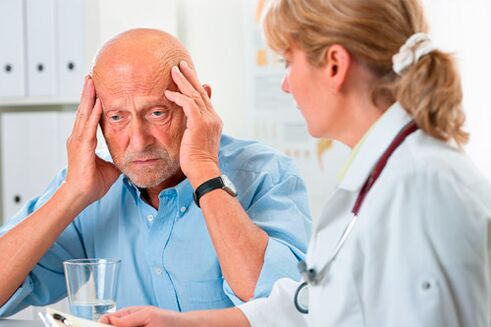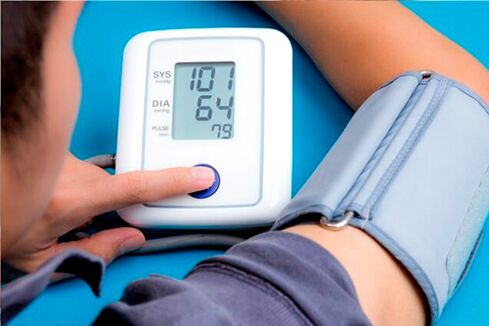Age-related characteristics in different life stages, extrinsic and extrinsic causes, changes in hormone levels, bad habits, as well as psycho-emotional factors can bemay affect blood pressure changes and lead to an increase in blood pressure. People don't always go to the doctor on time, so high blood pressure is constant. The article will tell about the symptoms of hypertension, as well as how it differs from hypotension.
First manifestation

High blood pressure is characterized by morphological changes in blood vessels that affect a person's general health. To understand whether a person has hypertension, and the symptoms that are characteristic of this pathology, you need to know the simplest methods of self-diagnosis that will help you correctly respond to a spike in indicators. numbers and prevent complications.
High blood pressure is one of the common diseases. Hypertension occurs in every third person, and is characterized by a high mortality rate in the severe phase. Only complex treatment that combines medication and maintenance of a healthy lifestyle can be successful.
Hypertension is characterized by a gradual, protracted, slow course and is initially characterized by the absence of severe symptoms. At elevated pressures, the presence of disease can be indicated by symptoms that appear periodically, including:
- pain in the occipital or temporal region;
- dizzy;
- hearing loss, tinnitus;
- blurred vision;
- fast heart rate and chest pain;
- nausea and vomiting reflex;
- feeling short of breath;
- worry;
- irritability;
- sweating or chills;
- recurrent nosebleeds.
A person with at least one of the above symptoms of hypertension, which may be the first symptom, is reason to visit a family doctor or therapist for diagnostic and preventive purposes, asSevere, untreated disease can lead to serious complications such as myocardial infarction and ischemic stroke.
Characteristics of symptoms
Arterial hypertension is always accompanied by headaches in the back of the head or temples, at the onset of pathology, analgesics are stopped. Its appearance is associated with a change in the lumen of the vessel in the direction of narrowing. People with high blood pressure headaches describe it as a dull ache or cramp in the back of the head, and a sharp, stabbing pain in the temple area.
Tinnitus and hearing loss in hypertension can be caused by malfunctioning hearing aid circuits.
Important! Sudden headache is a direct sign of pressure measurement.
Visual impairment in hypertension in the form of double, blinking dots (flies) in front of the eyes is associated with a lack of blood supply in the retina and impaired function of the optic nerve.
Nausea and vomiting reflex occur as a reaction to the onset of headache and dizziness, presenting with frequent heart palpitations and retrosternal pain due to dysfunction of the pulmonary circulatory vessels. A feeling of lack of air (difficulty breathing) characterizes high blood pressure, and is more common in obese patients of all ages.
The frequent occurrence of symptoms of high blood pressure can cause hypertension. And then, congestion of the skin on the face, anxiety, heart attack will join the above pathological signs. This condition will not go away on its own and will require urgent treatment.
Important! The cyclical symptoms of high blood pressure will prompt the patient to see a doctor and get treatment. The asymptomatic process of the disease steals a person's precious time.
Barometer indicator
To understand whether there is an increase in pressure, it is necessary to periodically measure the readings with a manometer under different conditions (abundance, poor), and also know their indicators.
The standard values are considered to be 120/80 mm Hg. Art. About 10 units from these figures is not a deviation. There are signs of an increase of more than 140/90 mm Hg. Art. , Combined with headache, feeling nauseous, heart attack are considered symptoms of arterial hypertension.
Important! Pressure in a person is always personal, it depends on the body and external causes. Tone "on the job" - these are the blood pressure numbers that the patient feels comfortable with. Patients with hypertension know their normal values and control them by prompt administration of antihypertensive drugs selected by the attending physician.
Features of the pathological levels
Signs of high blood pressure directly depend on the level of height of the indicators, in which there are 3 indicators in hypertension, which can be presented in the form of a table:
| Degree of high blood pressure | Systolic index (mm Hg) | Diastolic number (mm Hg) | The main symptoms of high blood pressure |
|---|---|---|---|
| 1 degree | 140-160 | 90-100 | They pass without an obvious clinic, are characterized by periodic increases, which rapidly normalize. Rarely, dizziness, insomnia, heaviness of the head, localized to the back of the head. |
| 2 degrees | 160-180 | 100-110 | Severe pain in the occipital or temporal region, accompanied by nausea, dizziness, weakness, insomnia. |
| 3 degrees | up to 182 or more | over 110 | Unbearable headache (especially in the morning), nausea, vomiting, ringing in the ears, visual disturbances, shortness of breath, sweating, tachycardia, swelling of the lower extremities, thirst, urinary disturbancesconvenient. |

Clinic early-stage hypertension can be mild. A person for a long time may not even be aware of the increase in pressure and the processes that develop in the vessels. The first and foremost signs of hypertension are unexplained irritability and increased fatigue.
Symptoms of high blood pressure in grade 2 and 3 hypertension with a systolic reading above 160 mm. leads to a hypertensive crisis, which is characterized by pronounced pain in the head of a varied nature, sensations of nausea, vomiting, blurred vision (fog, shroud) or flashing of small dots, as well as: tremors in the extremities, rapid pulse, feeling short of breath, heart attack, arrhythmia, loss of consciousness.
What is arterial hypertension - every hypertensive patient knows. It can be helpful to know how you can help yourself or a loved one before an ambulance arrives, when an emergency occurs for the first time:
- Place 1 tablet of validol or nitroglycerin under the tongue.
- Arrange for ventilation, remove tight clothing, and elevate the patient in bed (elevate the pillow).
- Place the mustard on the calf.
- Put inside 30 drops (1 tablespoon) of alcohol solution of valerian, wormwood.
- Take any pain reliever to relieve pain in the head, and lubricate the whiskey, forehead, neck area, and behind the ears with peppermint oil.
- You can soak your feet in hot water for 15 minutes.
In addition, doctors recommend performing a simple exercise to restore breathing. To do this, you should breathe deeply, hold your breath, and then exhale slowly. This should be done 3 to 5 times. The position of the body in this case should be backward.
Important! Without prompt support for a patient with hypertension, he can have a brain stroke or a heart attack. Since grades 2 and 3 are not curable, the patient must continuously control the rise in pressure.
Age characteristics
An increase in pressure in people over the age of 50 is often associated with early problems in the functioning of the heart and blood vessels, atherosclerosis, anemia, hyperthyroidism, and impaired kidney function. There may be dyspnea, marked leg edema, cardiac arrhythmias. Compared with men, women get the disease more often.
The symptoms of high blood pressure are always caused by the age-related changes in the vessels, which lose their elasticity. In addition to the typical clinical features of high blood pressure, intermittent squeaks, frequent fainting, dizziness when changing positions, head noises, and retrosternal compression may be added. There are also general malaise, decreased performance and weakness.
Because elevations in indices can occur in people of different ages, symptoms of hypertension in adolescents can manifest as early as 12 years of age (during puberty) and continue until the age of 12. 17. This is due to the restructuring of the body and changes in hormonal metabolism. . Characteristic signs that a teenager has high blood pressure are increased sweating, pounding heart, ringing in the ears, dizziness, headache at any time of day, insomnia, hot flashes, and regional discomfort. superiority. .
Important! To be sure that vascular disease is possible in this particular case, it is necessary to measure the pressure in the person several times in a row, preferably every 15 minutes. These indicators should be recorded and reported to the doctor for appropriate treatment. What medication to take - the doctor will decide.

If you see some symptoms associated with high blood pressure, you need to consult a doctor, examine and determine the real cause of the disease: tumors, kidneys, endocrine, blood vessels. Therapists, neurologists and family physicians will prescribe the appropriate treatment based on diagnostic data, functional characteristics of the body, age group, comorbidities and predisposition. allergy.
With hypertension, adrenoblockers, diuretics, ACE inhibitors, slow calcium channel blockers are prescribed.
Apply physiotherapy - electric sleep; acupuncture therapy; UHF therapy; infrared laser therapy, as well as traditional medicine. Patients with high blood pressure should follow a diet and consume enough fruits and vegetables.
Important! Preventive measures to prevent vascular pathology and the development of hypertension include timely medical examination, normalization of work and rest, a moderate diet, prevention of overweight, prevention of diseases. stressful situations, use adequate amounts of water, vegetables. , fruit, as well as eliminating dependence on nicotine and alcohol (if any).
Difference between high pressure and low pressure
Along with the signs of hypertension, of which the rate may be increased, there are manifestations of low blood pressure, known as hypotension.
Periodically reduced pressure is characterized by readings below 101/66 mm Hg. Art. It all depends on the age group, so the numbers can vary.
Despite the fact that the occurrence of intolerable paroxysmal headache occurs with both hypotension and hypertension, when the pressure is reduced, the following symptoms appear to distinguish high blood pressure fromshort:

- Poor health and weakness. From early morning, the patient feels weak and uncomfortable.
- Cold extremities. Constantly cold hands and feet.
- Noise in the ear (recurring present).
- Feeling of discomfort in the heart area, tachycardia. Each patient has their own feelings.
- Dizziness and frequent darkening (sometimes double vision) in the eyes. Such symptoms are characteristic not only in the morning, but also during the day.
- Drowsiness during the day, sleep disturbance at night. During the day, the patient feels the need to sleep all the time. The peak of activity begins in the evening. Tossed last night, no sleep.
- Digestion problems. Patients with low blood pressure often have gastritis, liver problems, constipation, indigestion, and dysbacteriosis.
These characteristic symptoms are common in young people, most of which are women. Reasons for low blood pressure are stress, lack of sleep, poor lifestyle, lack of vitamins, strict diet, hormonal disorders, physical and mental stress, some somatic diseases (endocrine, cervical osteonecrosis, liver, kidney. , EVD, sedentary lifestyle). Chronic depression can be a major cause of low blood pressure.
The first "rings" of the onset of the development of hypotension occur when, in the morning, a person gets out of bed feeling overwhelmed, irritable, and does not get enough sleep. After a while (everyone is completely individual) the headache comes on, which may not go away until lunchtime.
Here, the common symptoms with hypertension are the onset of nausea, vomiting, weather dependence, and fainting, a prolonged asymptomatic episode. You can increase low blood pressure by taking special medications, dietary therapies, herbal medicines, and maintaining a healthy lifestyle.
Therapy
Medicines that increase blood pressure include Eleutherococcus alcohol or ginseng, specific drugs. Caffeine has a similar effect.
Herbal medicine consists of taking a decoction and infusion of herbs from plants such as wormwood, lemongrass, ginseng, chrysanthemum, ha tho wu, ginger.
For patients with hypotension, it is acceptable to drink alcohol in small doses. A glass of red wine or 25 g of cognac for a week will benefit the body: it will dilate blood vessels and improve blood circulation. A cup of coffee in the morning will bring good mood.
Patients with low blood pressure should get enough sleep to feel alert (more than 8 hours a day), be physically active, eat a balanced diet, and also participate in moderate sports (morning exercise, swimming, etc. ). , aerobics, yoga, outdoor games), enema with contrast. bath, alternating them with massage.
Important! Untreated hypotension after age 40 can turn into hypertension.
Any person is advised to carefully monitor their blood pressure levels. It is necessary to use the manometer in a calm state, with good and bad health, after sleeping and before the night. It is advisable to record all indicators, compare and determine the pressure of "you", where the best performance and vital activities are recorded.
If the rising numbers persist for a long time, you should definitely consult your doctor to protect yourself from fatal complications in the future. Be healthy!





























